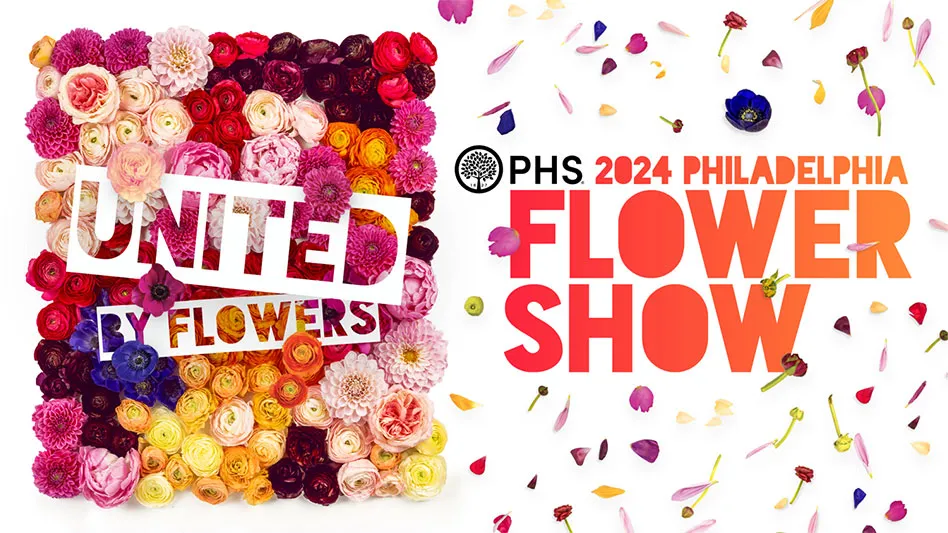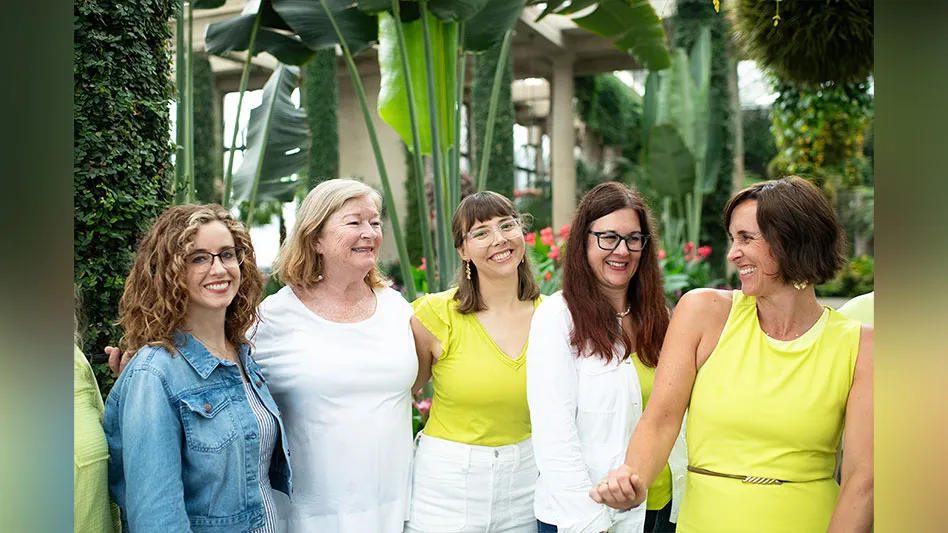The Dallas Arboretum Trial Program takes data on 7,000-plus annuals, perennials, woodies, grasses and trees each year, looking for the toughest of the tough. North Texas is a brutal climate that can swing from one extreme to another; six months of drought is usually followed by a month of flooding. Many of the arboretum’s trials focus on heat tolerance and ability to withstand low water requirements, because Texas is experiencing water restrictions like other states. We highlight some great drought-tolerant contenders here.
 Danziger varieties: Courtesy of Danziger / SAKATA VARIETIES: courtesy Sakata |
Gomphrena ‘Fireworks’ bred by PanAmerican Seed (annual)
This is a beast of plant that you can only truly appreciate once it has grown out. It’s somewhat leggy and sad-looking in nursery containers, but in the landscape this bold plant truly shines. Fuchsia flowers tipped with gold wave on 3-foot-tall stems and mounds of soft textured foliage. Once established, plants can survive easily on lower water use.
Leucophyllum langmaniae ‘Lynn’s Legacy’ (shrub)
Found by the legendary Texas plantsman Lynn Lowery, this evergreen shrub is truly a gift to the garden. Glowing lavender-pink flowers frost soft grey-green foliage off and on from summer until fall. Exceptionally drought-tolerant plants are best in Xeric beds, also outstanding in containers. Unlike many other cultivars, this one stays compact and seldom needs shearing, and it is more floriferous.
Ligustrum ‘Sunshine’ by Ball Ornamentals (shrub)
Choirs of landscape architects would be singing the praises of this plant — that is, if they knew about it. Compact, easily trimmed shrubs of pure gold are the perfect contrast for boxwood or barberry in formal garden design. Plants are supposedly sterile and will only reach 5 feet tall in 10 years. This plant can be trimmed to 1 foot in height, and it must be in full sun for best foliage color. It is semi-evergreen in milder climates.
Purslane Cupcake and Rio series by Dummen and Ball Floraplant, respectively (annual)
You have to love a plant that you can leave unwatered for two weeks while on vacation, then just sprinkle with water when you return and it almost instantly resurrects. These new cultivars really put on the flower power, and the foliage stays tight and compact. They are excellent in hanging baskets, spilling out of containers or growing in that spot by the mailbox where everything else bakes during the summer. The flowers on both of these new cultivars are much larger than many of the older selections.
Evolvulus Blue My Mind by Proven Winners (annual)
Who doesn’t like the cooling color of blue in their garden during the infernal heat of July? ‘Blue My Mind’ is a major improvement over the rangy and stingy blooming variety we’ve all been using for years. This new compact variety is also more drought-tolerant and heavier-blooming.
 Danziger varieties: Courtesy of Danziger / SAKATA VARIETIES: courtesy Sakata |
Celosia ‘Intenz’ by Ball Ingenuity (annual)
This plant is NOT for the faint of heart. These three-foot-tall plants are crowned with burning spikes of flaming fuchsia. Through the hottest weather that Texas can throw at it, ‘Intenz’ just keeps right on flowering. It took a hard frost to put this one down. For a Celosia, it also has a very nice foliage and habit.
Helichrysum Silver Leaf Yellow by Suntory (annual)
Trying to keep a basket watered during a Texas summer is nearly impossible; sooner or later, it’s going to dry out. That’s where ‘Silver Leaf Yellow’ comes in. This soft, flowing carpet of sage-green leaves is punctuated with golden polka dots, and it just laughs at attempts to kill it. Vigorous growth quickly cascades over the hanging baskets to 2 feet.
Catharanthus Cora Cascade Strawberry by Goldsmith Seed (annual)
Periwinkles were made for the hot humid south, but the Dallas Arboretum Trial program is ground zero for Aerial Phytopthera. It’s guaranteed that any Vinca the arboretum plants here is going to get a true test of resistance, and most don’t pass. This new ‘Strawberry’ introduction features soft, creamy, pink flowers with a strawberry-red center that curtain 2 feet over hanging baskets all summer long. Like all Vinca, this one was drought-tolerant and did not require daily watering to keep alive.
Lantana Lucky Pot of Gold by Ball Floraplant (annual)
It’s almost impossible to drive a mile in Texas and not see a planting of Lantana. Drought, heat and humidity only make this plant grow faster. Not too big and not too small, this 1-foot-tall variety is just right. Wide balls of burning gold flowers bloom all summer long. As a matter of fact, this variety actually blooms better if you let it get thirsty between watering.
Gaillardia Galya series by Danziger (annual)
Flame-like flowers in red, orange, yellow and bicolor come in double and single forms in this new hybrid from Danziger. Bred from the Texas native G. pulchella, this plants relishes heat and drier soils but will also tolerate cool weather and seasonal deluges. Once the weather heats up, this plant never goes out of flower.
Portulaca Samba series by Athena Brazil (annual)
A pass-along plant from your grandmother’s time, this Portulaca laughs at dry weather. Broken stems lying on the sidewalk have been known to flower for three weeks before they finally give up. Two-and-a-half-inch flowers of magenta, white or a combination of the two dot the foliage all summer. Plants are only slightly slower than kudzu in their growth habit and will quickly spread to 3 feet either across the ground or out of baskets. Forgot to water for two weeks? No problem, this plant looks just the same.
 Danziger varieties: Courtesy of Danziger / SAKATA VARIETIES: courtesy Sakata |
Hesperaloe Brakelights by Mountain States Wholesale Nursery (perennial)
The plant commonly called false red yucca for years is perplexing: where is the red? Then comes the aptly named Brakelights, which has a true red flower and stems. Drought tolerance is this plant’s middle name. They’ve been seen growing in Arizona with no supplemental irrigation at all, and they’re almost constantly in flower from late spring to fall.
Agave ovatifolia – Whale’s tongue Agave (perennial)
Another plant that Lynn Lowry found in Mexico has quickly become the favorite Agave across the state. These zone 7, hardy, icy-silver plants form large 5-foot rosettes. Unlike many others of this genus, this one does not form pups. Able to withstand drought, hot summers, and cool wet weather as well.
Verbena ‘Princess Blush’ & ‘Princess Dark Lavender’ by Southern Living Plant Collection (perennial)
Many verbenas in the Texas climate quickly succumb to high night temperatures and powdery mildew, but not this one. Both colors of this variety are vigorous plants that flower off and on all summer on mildew-free foliage. As a matter of fact, the flowers continue right up until a hard freeze finally puts them to slumber for the winter. Mat-forming foliage requires low water to keep flowering.
Additional varieties
Thirsty for more? Here are some additional drought-tolerant varieties — provided by their respective companies — that are either already introduced or soon-to-be-introduced to the market.
 Clio Magenta |
Danziger
Touting excellent branching and a strong upright structure, Clio Magenta cleome features dark foliage and long, continuous flowering. This seed-sterile plant also has non-stick leaves and exceptional garden performance.
The Santana series lantana is a semi-trailing structure that is great for ground cover as well as baskets. It features long-lasting, abundant flowering and interesting diversity of color.
Scaevola ‘Blue Haze’ and Scaevola ‘Blue Wind’ are elegant and floriferous low-spreading ground cover plants whose flowers are concentrated in clusters at the edge of the leafy spikes. Suitable for rockeries and borders.
Sallyfun Salvia farinacea offers long blooming periods and excellent garden performance. Suitable for pot plants, large containers, or as a center plant in a combination, they flower early and uniformly, unlike seed varieties.
 Red Fox Cupcake "Cherry Baby" |
Dummen
RED FOX Cupcake portulacas performed beautifully at trial sites around the country last summer (2012), one of the hottest on record in many areas. They loved the tough conditions, showing large, bright-colored flowers in abundance. They feature good branching and controlled growth and are good trailers, making them an excellent choice for landscape and basket applications.
Sakata
As the first Gomphrena on the market, ‘Pinball’ stands apart with its strong mounding habit and vibrant color for higher retail sell-through. The unique texture, mounding habit and continuous flowering make Pinball an ideal component plant for mixed containers.
Sakata’s new generation of Profusion Double zinnias (Profusion Double Deep Salmon, Profusion Double Yellow and Profusion Double Hot Cherry) offer multi-layer blooms and feature reliable production uniformity, as well as impressive disease, drought and heat tolerance. Large, double blooms are ideal for both the landscape and in large containers.
Syngenta
Company note: The next nine plants must be established in the landscape in order to exhibit drought-tolerant qualities. They are not — nor are most other spring annuals — drought-tolerant from the beginning.
A new GoldFisch Heat Lovers series, Starcluster is bred to perform through summer heat. Its large flower clusters are supported by strong stems to ensure consistent quality and shelf appeal at retail. A well-branched habit makes Starcluster pentas a showstopper in gallons or larger containers and landscapes. Consumers will appreciate Starcluster for its low-maintenance performance that requires no deadheading as new flowers form over spent blooms. Available in four colors: White, Rose, Red and Lavender.
 COURTESY SYNGENTA |
Sriracha is a totally new, heat-loving Cuphea series from seed that offers season-extending opportunities for growers and retailers. Available in three colors, Sriracha provides vibrant color from spring through the heat of summer. Sriracha is a faster, cost-effective alternative to specialty vegetative varieties. Compact, well-branched plants offer excellent series uniformity suitable for six-inch or gallon containers.
Kiss Frosty Orange gazania is an all-new color for 2013-14. Bright orange flowers pop against silvery foliage for an eye-catching combination. It’s an ideal crop for summer to extend the retail bedding-plant sales window. Uniform habit and flower timing simplify production, even at high densities. Nicely mounded, well-branched plants work well for four-inch or larger containers.
An improved variety this year, Cora Apricot Improved features stronger color with less fading under high heat. Its true F1 vigor results in well-branched plants that thrive in heat and humidity and offer the best consumer solution for troubled landscapes. Cora is one of two vinca series from Syngenta that offer patented resistance to many strains of aerial Phytophthora. Huge, overlapping, high-quality blooms sit atop glossy foliage.
Caliente Geranium began the hybrid-geranium trend. Superior heat and edema tolerance classifies Caliente as a GoldFisch Heat Lovers series, which will bloom all summer with vigorous, semi-trailing growth. Caliente is low-maintenance and forgiving of water abuse. Self-cleaning flowers and a naturally well-branched habit contribute to the series’ best-in-class landscape performance.
Bandana Lantana thrives in the landscape under full sun, summer heat and moderate moisture conditions. Bandana exhibits drought tolerance and should be allowed to dry between irrigations. Large flowers bloom repeatedly throughout the summer. Little to no seed set as well.
The Bombay Scaevola self-cleaning plant thrives in dry, hot, sunny locations. It is extremely drought and heat tolerant and will also tolerate salt and humidity. Excellent branching gives Bombay a consistent, semi-trailing growth habit and creates a groundcover effect in land-scape beds.
Euphoric Euphorbia blooms generously even under the most stressful summer conditions. For maximum flowering, Euphoric should be planted in an area with at least six hours of full sun. Vigorous and well-branched, Euphoric has dark green foliage that spreads quickly in the landscape. It is low-maintenance and self-cleaning, requiring no deadheading.
 Eucomis 'Glow Sticks'. Courtesy Terra Nova Nurseries |
Terra Nova Nurseries
Echinacea ‘Vanilla Cupcake’ is an anemone-type variety with double white flowers and a strong, upright structure. Featuring a compact, multibranched habit, it has 19 in. foliage height, 16 in. foliage spread, and 22 in. flowering height. For zones 4 to 10.
Eucomis ‘Glow Sticks’ features glowing foliage that changes from coppery-rose to burnished gold. The foliage is very wavy when grown in full sun. Upright and neat-growing, this variety has 15 in. foliage height, 18 in. foliage spread, and 18 in. flowing height. Great for zones 6 to 10, sun to part shade.
Terra Nova’s Heuchera ‘Paprika’ touts glowing coral foliage in the spring and veiled cherry-coral foliage in summer and fall. Medium-large leaves on a medium-sized plant feature 8 in. foliage height, 16 in. foliage spread, and 12 in. flowering height. For zones 4 to 9, part shade (full sun in the Pacific Northwest).

Explore the July 2013 Issue
Check out more from this issue and find you next story to read.
Latest from Garden Center
- Weekend Reading 5/17/24
- GardenComm 2024 Annual Conference registration is open
- Landmark Plastic celebrates 40 years
- Proven Winners introduces more than 100 new varieties for 2025
- Weekend Reading 5/10/24
- The Family Business, Part 2: Agreeing (and disagreeing) on capital investments
- Registration opens for Darwin Perennials Day
- Weekend Reading 5/3/24





